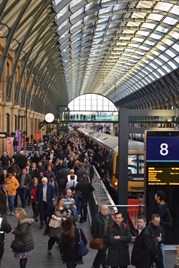 Read the peer reviews for this feature.
Read the peer reviews for this feature.
Download the graphs for this feature.
A well-rehearsed cliché appeared in the opening weeks of 2015, among the comment pages of newspapers and the many websites analysing political opinion ahead of the 2015 General Election.
The election is “too close to call”, the commentators said, although if you strip away the spin, the bias and the hidden agendas, you will invariably find that one party always has the edge.
By mid-February, more published polls from respected polling organisations had Labour marginally ahead of the Conservatives (by just one or two points) than those that had the Conservatives ahead.
Another sizeable chunk of polls measured both major parties as neck and neck. One website even had both parties as set to win exactly 271 seats each, which would mean that without support from smaller parties such as the Liberal Democrats or the Scottish National Party, neither could win an overall majority of 326 seats. That magic number has never looked more difficult to achieve than at any time since at least 1974 - the last year of two General Elections.
By the time this issue of RailReview is in print, such predictions may have changed completely again, with one party surging ahead of the other and increasing its chances of an overall majority.
But regardless of whether or not one party gains a clear advantage, some sort of stable or long-term arrangement will be needed to see the next government through to 2020, under the new regime of fixed-term parliaments.
And whatever the outcome, the rail industry will remain a politicised subject open to much debate. The past five years have shown that more than ever, with high-speed rail becoming increasingly important on the legislative agenda, the go-ahead for Crossrail and the start of major construction work, and a great many other schemes being authorised (many wrapped up in the £38 billion of funding for Control Period 5 and beyond).
The devil is in the detail, however, and the nature of party manifestos means that they aren’t traditionally known for their fully costed, line-by-line plans for various policy areas - certainly not in areas as technical as transport. The headline policies win votes… the detail comes later. Or maybe those headline policies are discreetly shelved or even forgotten.
To better understand what the parties might do for rail beneath the high-level commitments, we must look at their record (an easier task for the Coalition parties), and at a series of speeches, statements and policy positions for the other parties (particularly Labour).
Hopefully for the rail industry, the tap of investment will not be turned off any time soon. Barring a political earthquake, the case for investment in rail as a contributor to economic growth has been made, with the industry enjoying the sort of consensual support that hasn’t been present for many years.
RailReview asked the three main parties five questions relating to what they would do around the structure of the industry - and how they would fund it (see page 11). The responses were mixed, with some parties preferring to focus on their own specific rail promises. At the time of writing, none of the parties had written the final form of their manifesto.
The message from the Conservatives is essentially ‘more of the same’. The party’s spokesman refused to answer RailReview’s questions directly, although of Secretary of State for Transport Patrick McLoughlin did release a statement.
“I am incredibly proud of the Conservative party’s record on rail in this parliament - a time of expansion, investment and ambition. That will continue after the election under a Conservative government,” the minister said.
“Since 2010 Britain’s railways have seen passenger numbers increase by 25% and investment grow to meet that demand. Infrastructure development is at the heart of the Conservatives’ long-term economic plan.
“With government support Network Rail is investing £38bn in our railways on projects that will run through the next parliament, including electrification of key main lines and urban routes. Only the Conservative party can guarantee that this vital investment will continue as part of a costed, affordable plan for government. We will work with industry, including Network Rail, to make sure this investment is carried out effectively and affordably, so that passengers get the benefit.”
McLoughlin restated the promises of high-speed rail that are already being steered through Parliament, as well as investment in railways in the north of England.
“A Conservative government will also raise its ambitions for the future, backing HS2 with a funded plan for the start of construction following Royal Assent, and working with northern cities and businesses to create the infrastructure for a Northern Powerhouse economy, including steps towards a fast trans-Pennine rail link.”
On franchising (an area that had some very difficult moments during this government, most notably in 2012), McLoughlin promises continuation of the new focus on quality, particularly in areas that have been starved of new (or at least more modern) rolling stock.











